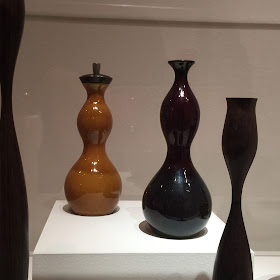 |
| Isamu Noguchi, Trinity, 1945, Gregory, 1948, Strange Bird (To the Sunflower) Photo taken from the Hirshhorn's Facebook page |
Isamu Noguchi's many sculptures that are part of Marvelous Objects deal with an unexpected part of the artist's life and work. Noguchi was interned in a prison camp in Arizona for Japanese-Americans during World War II. Whatever the horrors of his experience, he dealt with it as an artist does -- making art and using creativity to express the experience by transforming it.
 |
| Isamu Noguchi, Lunar Landscape, 1944 |
 | ||
| Strange Bird (To the Sunflower), 1945 Noguchi Museum, NY |
From the beginning of time, "humans have wanted a unifying vision by which to see the chaos of our world. Artists fulfill this role," said Japanese artist Hiroshi Sugimoto.
I'm reminded of the ancient Greeks who created satyrs and centaurs to deal with their animal nature. At the Metropolitan Museum of Art, there's a small Greek sculpture of a man and centaur from about 750 BCE, the Geometric period. The man confronting the centaur seems to be taming him or subduing his own animal nature. Like Noguchi's sculpture, it has hybrid forms and angularity, but it's made of bronze. Noguchi's sculpture is of smooth green slate, which gives it much of its beauty and polish.
 |
| Man and Centaur, bronze, 4-3/4" mid-8th century BCE Metropolitan Museum |
Noguchi was a landscape architect as well as a sculptor. When designing gardens, he rarely used sculpture other than his own. Yet he bought garden seats by ceramicist Karen Karnes. A pair of these benches by Karnes are now on display at the National Museum for Women in the Arts' exhibition of design visionaries. Looking closely, one sees how she used flattened, hand-rolled coils of clay to build her chairs. The craftsmanship is superb. It's easy to see how her aesthetic fit into Noguchi's refined vision of nature.
 | |
| Karen Karnes, Garden seats, ceramic, from the Museum of Arts in Design, now at NMWA |
 |
| Ruth Asawa, Form-Within-Form Sculpture, 1952, at NMWA |
There's an interesting piece by Ruth Asawa. It's a delicate wire crochet that hangs as a sculpture. It's interior and exterior forms are seemingly drawn in the air. A photo found online shows here surrounded by her children and several of the sculptures. The interior forms are like babies in the womb.
Asawa, a Japanese-American artist, like Isamu Noguchi, had been in a prison camp during World War I, when she would have been in high school. It was there that other prisoners taught her to draw. After the war, Asawa studied at Black Mountain College in North Carolina, as did other artists in the show.
When she reflected on the experience of internment Asawa said: "I hold no hostilities for what happened; I blame no one. Sometimes good comes through adversity. I would not be who I am today had it not been for the Internment, and I like who I am." Asawa settled in San Francisco and became an advocate for the arts in education. The DeYoung Museum of Art held a major retrospective of her work in 2006.
 |
| Eva Zeisel, candlesticks and Pepper and Salt Shaker, at NMWA |
Many of the ceramic artists who really take their cues from the human body. Perhaps the most famous of them is Eva Zeisel, who was born in Hungary but had a long and distinguished career in beginning in Germany and then the United States. Her works have been sold by Crate and Barrel, Design Within Reach, Red Wing Pottery and Hall China Company. For more information see theNMWA's blog at broadstrokes.org.
 |
| Eva Zeisel, Gravy Boat at NMWA's Pathmaker's exhibition |
I like her Salt Shaker and Pepper Shakers and her candlesticks which have lovely flowing curves. Zeisel's designs were picked up by major American china companies of the 20th century. The most sensual of pieces to me, however, is a delicate white gravy boat. Its handle reminded me of lips, and I think of how ancient Greek pottery is usually described by the neck, shoulders, belly, mouth and foot.
Eva Zeisel's Belly Button Room Divider was a model made of ceramic and metal rods, but it was never manufactured. The colors shock and glow. It's a nice change from all the subdued colors and also a blast of fun. It seems like Zeisel had a wonderful sense of humor. (Many of the works in this blog have important points of comparison with my last blog about Louise Bourgeois.)
 |
| Eve Zeisel, Belly Button Room Divider, 1957 |
No comments:
Post a Comment
Note: Only a member of this blog may post a comment.